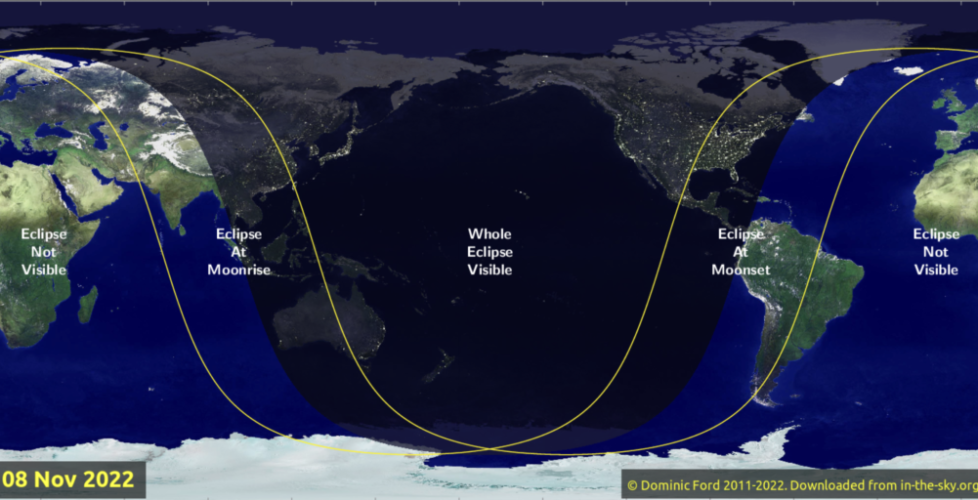Total Lunar Eclipse, Nov 7-8
Early Tuesday morning, November 8 (i.e., Monday night, November 7), there will be an “Election Day” total lunar eclipse (when the Moon goes into Earth’s shadow) visible from North America. Weather permitting, everyone on Earth’s dark (night) side will be able to see it. No optical aid is needed — just use your eyes (though the view through binoculars should be interesting as well). Here’s some useful information; more details can be found at the end of the message.
We will be on Standard Time by Monday (switching from Daylight Time this Saturday night, Nov. 5). Unlike the case in a total *solar* eclipse, the lunar eclipse will occur simultaneously from any location where it is visible. However, you have to adjust for different time zones. Here are the relevant times (all are Tuesday early morning — that is, Mon. night after midnight):
Partial eclipse begins: 1:09 am PST,
2:09 am MST,
3:09 am CST,
4:09 am EST.
Total eclipse begins: 2:16 am PST,
3:16 am MST,
4:16 am CST,
5:16 am EST.
Total eclipse ends: 3:42 am PST,
4:42 am MST,
5:42 am CST,
6:42 am EST.
Partial eclipse ends: 4:49 am PST,
5:49 am MST,
6:49 am CST,
7:49 am EST.
(Subtract 2 hours from the above times, if in Hawaii.)
The time of sunrise (and thus moonset, since the full Moon will be opposite the Sun in the sky) depends on where you are in your time zone and also on your latitude — but *roughly* 6:40 am for much of the USA. So, from the eastern USA, the *total* eclipse ends around the time of sunrise, in a very bright sky. The rest of the USA can watch the entire total eclipse in dark skies. Over most of the USA, Mexico, and Canada, the Moon will be high in the sky throughout the eclipse (especially during the first partial phases and totality). However, as seen from the east coast, you’ll need a relatively low, clear western horizon.
The eclipse will also be visible from Australia, New Zealand, Siberia, and much of Asia, though it will be on Tue. night with the Moon in the east (not Tue. morning with the Moon in the west, as in N. America). See the attached map, courtesy Dominic Ford from in-the-sky.org . You can also consult the excellent website https://www.timeanddate.com/eclipse/lunar/2022-november-8 for a detailed map and to see whether the eclipse will be visible from a specific location (put your location in the “Eclipse Lookup” box on the right-hand side of the web page). Another good website is
https://earthsky.org/astronomy-essentials/total-lunar-eclipse-nov8-2022/ .
Totality will last about 1 hour 26 minutes, a relatively long total lunar eclipse (because part of the Moon will pass near the center of Earth’s shadow); if you include the partial phases, it lasts 3 hours 40 minutes. In case of clouds, rain, or snow, don’t give up hope (unless the forecast is truly hopeless)! The long duration of the eclipse means that you might occasionally get a good view of the Moon through a break in the clouds.
Wishing you clear skies during the night of November 7/8, 2022,
Alex

